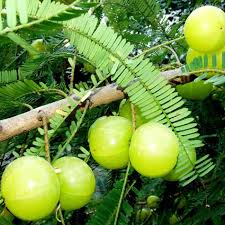Amla
| Botanical Name: | Emblica officinalis |
|---|---|
| English Name: | amla |
| Local Name: | Amla |
More Information
Unique identification feature
- The tree is small to medium in size, reaching 1–8 m (3 ft 3 in–26 ft 3 in) in height. The branchlets aren't glabrous or finely pubescent, 10–20 cm (3.9–7.9 in) long, usually deciduous. The leaves are simple, sub sessile and closely set along branchlets, light green, resembling pinnate leaves. The flowers are greenish-yellow.The fruit is nearly spherical, light greenish yellow, quite smooth and hard on appearance, with six vertical stripes or furrows. Ripening in autumn, the berries are harvested by hand after climbing to upper branches bearing the fruits.The taste of Indian gooseberry is sour, bitter and astringent, and it is quite fibrous. In India, it is common to eat gooseberries steeped in salt water and turmeric to make the sour fruits palatable
Unique identification feature
- Medicinal use:- Emblic is of great importance in traditional Asiatic medicine, not only as an antiscorbutic, but also in the treatment of diverse ailments, especially those associated with the digestive organs. In Thailand emblic fruits are traditionally used as an expectorant, antipyretic, diuretic, antidiarrhoeal and antiscorbutic. The fruits, bark and leaves are rich in tannin. The dried pulp of unripe fruits contains 18 - 35% tannin; the content of ripe fruits is much lower. The dry stem bark contains 8 - 20% tannin. The bark of twigs is usually richer, containing 12 - 24% tannin on dry weight basis. Leaves may yield 22 - 28% tannin The tannins of the fruit belong to the group of gallotannins and ellagitannins, giving on hydrolysis large amounts of gallic acid, small amounts of ellagic acid, and glucose. Many of the medicinal applications of the fruits can be ascribed to the presence of ascorbic acid and to the astringent action of the tannins, but the fruits contain other active compounds as well. Fruit extracts showed anti-oxidant and antitumour activities in in-vitro and animal tests. They also exhibited cholesterol-lowering, antitussive, anti-ulcerative and hepatoprotective properties and showed potent inhibitory activity on HIV reverse transcriptase; for the latter activity putranjivain A was the most active compound isolate.Many of the medicinal applications of the fruits can be ascribed to the presence of ascorbic acid and to the astringent action of the tannins, but the fruits contain other active compounds as well. Fruit extracts showed anti-oxidant and antitumour activities in in-vitro and animal tests. They also exhibited cholesterol-lowering, antitussive, anti-ulcerative and hepatoprotective properties and showed potent inhibitory activity on HIV reverse transcriptase; for the latter activity putranjivain A was the most active compound isolate.Leaf extracts have shown inhibitory activity on human leukocytes and platelets, which at least partly confirms their anti-inflammatory and antipyretic properties. The juice of the fruit is also given in order to strengthen the pancreas of diabetics, as well as in the treatment of eye problems, joint pain, diarrhoea and dysentery. Other:- The leaves are used for dyeing matting, bamboo wickerwork, silk and wool into brown colours. Grey and black colours are obtained when iron salts are used as mordants
Planting and Care
- The seed is taken from over-ripe fruits, which are sun dried to facilitate removal of the stone, or are cut in half right through the stone. The extracted seeds are given the float test and 100% of those that sink will germinate. In 4 months, seedlings will have a stem diameter of 8 mm and can be budded or grafted if required.Semi-hardwood cuttings, collected from the middle portions of vigorous shoots of young trees and planted in beds at a temperature of about 33°c, produce a high percentage of rooting.




